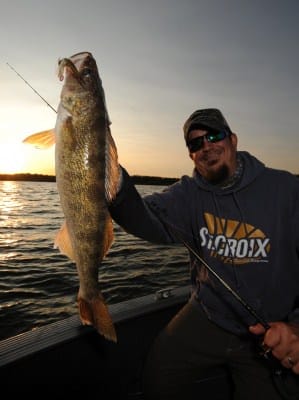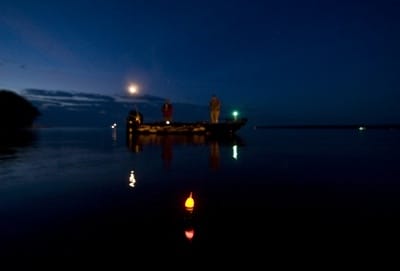
There are challenges, and then there are challenges. Climbing Mount Everest is a challenge. Going over Niagara Falls in a five-gallon bucket is a challenge. Walking through the national pit bull festival with a T-bone strapped to your naked backside; that’s a challenge. Actually, that’s a Death Wish, but that’s another story for another time, perhaps.
Anglers have their challenges as well, and few species can be as trying as can the walleye. ‘Eyes during the daylight hours can prove frustrating. They ignore presentation after presentation. Fast trolling, slow trolling, jigs, crankbaits, spinner rigs – it doesn’t seem to matter. The fish just seem to have developed the ultimate case of lockjaw. That is, however, until the sun sets. Then a change comes over these notoriously fickle fish. The hot button is switched into the ON position, and the bite comes alive. It’s not easy, and it’s by no means a guarantee, but walleye fishing after the sun goes down can prove some of the most incredible angling of year.
The Where
While it’s well documented that fishermen very seldom agree on anything, there is what I’ll call a common thread when the topic turns round to walleyes after dark – shallow. With their light-sensitive eyes, walleyes, for the most part, show a tendency to huddle in the deep throughout the course of the day. Switch off the sun; however, and these predators crawl out of 20 feet to spend the night cruising water that may only be 3 feet, or in some case, less.
One of the hottest dusk ‘til dawn walleye bites I’ve ever experienced took place on a quarter-mile stretch of flooded gravel road. During the day, small schools of ‘eyes would stage in a slow-current creek channel that averaged 12 to 14 feet in depth. Come night, however, these same fish would move up onto the gravel into 3 and 4 feet of water. Now, shallow-running crankbaits became the prey du jour, and it didn’t take long to fill six-fish limits with ‘eyes running from 1 to 3 pounds. The mosquitoes in June were horrific, but the fish made each and every red raised welt worth the itch.
Flooded roads are just one area worth investigating; other potential nighttime hotspots include sand flats adjacent to deeper water, i.e. creek channels, rip-rap shorelines, or the gently sloping sides of rock humps rising out of – again – deeper water. Day or night, walleye fishing – successful walleye fishing – is all about structure. It’s important to remember that structure here doesn’t necessary translate into a readily visible bit of topography, e.g. a rock hump, but can be something as subtle as gentle undulations in an otherwise flat and featureless sand bottom. Quality electronics, then, become as important a piece of equipment as is the rod and reel. The equation for nighttime walleyes can be elemental – find the structure in shallow water, and chances are you’ll have found the fish.

How, and the Gear
Night-fishing for walleyes lends itself to several different styles of angling, any one of which can best another on any certain evening. Leading the pack, perse, in terms of popularity and productivity is the art of casting crankbaits over and around the aforementioned bits of shallow-water structure. The lures themselves are many, with well-recognized names such as Shad Raps, Reef Runners, STORM Lures’ Hot ‘n Tots, and 6A Bombers leading the pack. My favorite crankbait, and one I’ll throw day or night, is the Wally Diver by Cotton Cordell. Colors or patterns are often dictated by the primary bait source – shad, perch, or shiners, to name just three; however, two perennial choices, and a pair that have proven themselves time and time again across the country are Fire Tiger, a blend of chartreuse, orange, green and black, and my personal pick, particularly in a Wally Diver, red ‘n white. Experimentation, be it night or day, remains key when it comes to unraveling what the ‘eyes want at any given moment.
Crankbaits aren’t only option for after-dark walleye hunters. A slow retrieve with a RoadRunner lead-head jig tipped with a ‘crawler or lively minnow can fill a stringer; so, too, can leeches or larger 4- to 5-inch minnows fished underneath a lighted or glow-in-the-dark slip bobber.
Rod and reel combos used for nighttime walleye fishing will share a common one-word characteristic – sensitive. Much of what happens on the water after dark, at least on the part of the angler, is accomplished largely by feel, and as such, a quality rod and reel, one which transmits every bump, tick, or tap immediately back to the hands is vitally important. My go-to after-dark walleye rig consists of an Old School 6-foot medium action Berkley Series ONE IM7 spinning rod mated to a Shakespeare Intrepid 3030 reel spooled with simple No. 6 monofilament. With this, I can cast comfortably well into the wee hours of the morning and can easily feel the often subtle take of a feeding walleye. While, and this is important, maintaining ample backbone to subdue something as large as my personal best for walleyes, a 31.5-inch Columbia River brute that weighed 14.5 pounds taken Aug. 2, 1996 just as the sun was sinking behind the Cascade Mountains. And on a 5/8-ounce chartreuse jighead rigged with a No. 6 stinger hook and tipped with a nightcrawler.
Not that I remember much about it. No, sir, not at all.
The Union Sportsmen’s Alliance website is designed to provide valuable articles about hunting, fishing and conservation for members of AFL-CIO affiliated labor unions and all sportsmen and sportswomen who appreciate hunting and fishing and want to preserve our outdoor heritage for future generations. If you would like your own story and experience from the outdoors to be considered for our website, please email us atUSAmembers@unionsportsmen.org.



